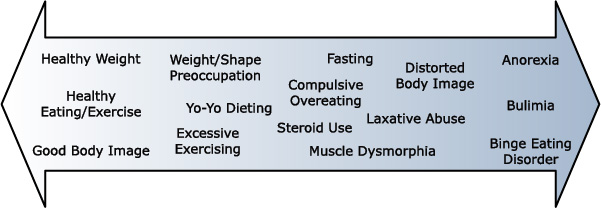What is Disordered Eating?

Eating attitudes and behaviours vary along a broad continuum. The 'healthy' end of this continuum describes someone who practices healthy eating and exercise habits most of the time, generally likes their body and feels comfortable in their own skin, and whose sense of self does not dramatically fluctuate based on the numbers on the scale. The other extreme of the continuum describes someone struggling with an eating disorder - bulimia, anorexia, or binge eating disorder.
There are many eating attitudes and behaviours in between, including body dissatisfaction, preoccupation with food, weight, and body image, yo-yo dieting, fasting, excessive exercising, compulsive overeating, steroid use, laxative abuse etc.
Disordered eating means "eating in irregular and chaotic ways - dieting, fasting, bingeing, skipping meals - or it may mean consistently under-eating much less or overeating much more than your body wants or needs" (Berg, 2000).
While the majority of us may occasionally exhibit disordered eating - that is, eating for reasons other than to satisfy a physiological hunger - the various eating disorders described in these pages are characterized by recurring cycles of behaviour which are prompted by a desire to cope with feelings (such as anger, depression, shame, boredom, anxiety, hopelessness, etc.) and have negative consequences (for example, health problems, mood disturbances, family relationship disturbances, and an increase in the very feelings the behaviour attempted to suppress).
I see my body as an instrument, not an ornament.
- Alanis Morissette
Use the ONLINE SCHEDULER to view and book upcoming session times.


